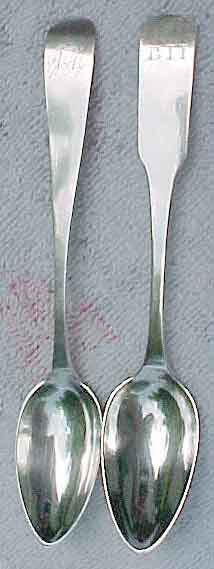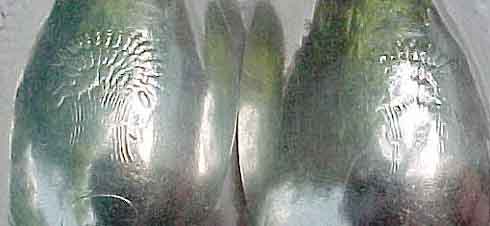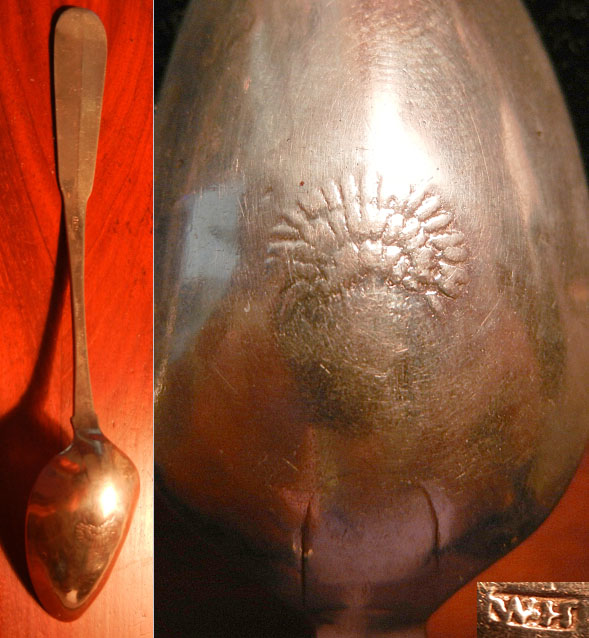|
A GLOSSARY of MILLED BANDS
|
|
| How to Post Photos |
REGISTER (click here)
|
|
A GLOSSARY of MILLED BANDS
|
|
| How to Post Photos |
REGISTER (click here)
|

|
 SMP Silver Salon Forums SMP Silver Salon Forums
  American Silver before sterling American Silver before sterling
  The Haversticks of Lancaster and their Wheat-back Spoons The Haversticks of Lancaster and their Wheat-back Spoons
|
| next newest topic | next oldest topic |
| Author | Topic: The Haversticks of Lancaster and their Wheat-back Spoons |
|
Brent Posts: 1507 |
  
    Picture-back spoons are very popular with coin silver collectors, and with good reason. Spoons featuring bird-backs were the focus of a recent exhibit at Winterthur (see a previous thread in this forum for a complete run-down of the exhibit). Lesser known and rarer motifs do exist, however, some of which were displayed at the bird-back exhibit as well. One of these is a sheaf of wheat, apparently used only by the members of the Haverstick family of Lancaster, PA. William Haverstick Sr. and Matthias Haverstick were born in 1756 and 1770, respectively, and both were silversmiths. William Sr. had three sons, William Jr., John and George who also became silversmiths. Judging from the pieces attributed to the Haversticks in Vivian Gerstell's "Silversmiths of Lancaster, Pennsylvania 1730-1850", the family members all made similar looking articles and may even have marked one another's work. Many of the existing Haverstick family spoons seem to be decorated with a picture back. The Haversticks appear to have shared the dies, or swages, used to produce the decorated backs. The Haverstick family bird-back swage still exists, and is still in the Haverstick family. It was on loan to Winterthur for the bird-back exhibit, and was a thrill to see. Judging from the two spoons pictured here, the Haversticks also shared the sheaf-of-wheat swage. The downturned rounded end spoon on the left bears the mark of William Haverstick Sr. or Jr., while the "finless-fiddle" on the right has the mark of George Haverstick. Another sheaf-of-wheat back spoon with the WH mark is illustrated in Gerstell's book. Although the decoration is badly rubbed on the George Haverstick example, careful comparison reveals it to be the same as the on the William example. The sheaf-of wheat was a popular decoration for the front of the handle, and many coin silver spoons with sheaf-of-wheat handles are known. Apparently, though, only the Haversticks decorated bowl backs with it. If anyone has a non-Haverstick SOW back spoon, I would love to hear about it. Anyway, enjoy! Brent [This message has been edited by Brent (edited 07-22-2002).] IP: Logged |
|
flabob Posts: 39 |
  
Hi Brent That's an interesting post and the exhibit at Winterthur must have been awesome. I have Dr. Fenmore's book on the bird-back spoons, which is also greatly informative, and greatly so with the pictures of the dies used for these spoons, plus all the other inormation. I am also answering your request for any other sheaf of wheat picture backs. They (6) are a bit under 5 inches, finless and with downturned ovals with a round raised single drop, monogrammed with block letters, with a W.C maker mark as well as a lion passant. The W.C is overstruck over another mark. I will try to get pictures posted on here soon for everyones viewing. Thanks again for that informative post. IP: Logged |
|
flabob Posts: 39 |
  
Pictures of the mark and sheaf of wheat picture back spoons IP: Logged |
|
swarter Moderator Posts: 2920 |
  
The second mark on these spoons is the Lion Passant (shown upside down in the third picture). These are typical English picture backs of the period, probably London made. [This message has been edited by swarter (edited 05-24-2012).] IP: Logged |
|
flabob Posts: 39 |
  
Hi Swarter and thanks for your reply. The wheat back design looks very similar or even a match to the Haverstick one. Could it have possibly been the usage of the same swage or merely a copy of an English one? I'm not very familiar with the English picture backs, ie the period of usage, relative popularity, main areas of production, etc. The maker mark was reviewed against known English makers, but with no luck. Is it possible, that since none of the six spoons has a date letter, nor monarchs head, that these are an early NY lion passant and thereby American made? Thanks again - for the info and the posting. bob IP: Logged |
|
agphile Posts: 798 |
  
I'd agree wth Swarter and would suggest London c.1765. The maker possibly William Chatterton (one of his marks is WC with a pellet in an oblong cartouche). Teaspoons of this date are marked with just maker's mark and lion passant. English picture backs start in the 1730s with simple shell backs. The more pictorial patterns come in rather later. By about 1780 or perhaps a bit earlier, when Old English has pretty well completely replaced Hanoverian as the pattern of choice, picture backs become very much rarer in England. IP: Logged |
|
flabob Posts: 39 |
  
Thanks Agphile for that information, which has led me to some discoveries while searching in that direction. An interesting UK web site specializing in sugar tongs shows a W.C mark on a pair of sugar tongs and attributes it to William Chatterton and gives a brief history of he and his several marks. His first was entered on April 7, 1762 as a "small" worker. It goes on to state that
Another search came upon a Christie's auction of a William Chatterton piece with the description of his mark being punched over another mark. This is interesting, but may just be a coincidence, because 3 of the 6 spoons show his mark punched over another mark, of which picture 4 above shows it best. The underlying mark shows the last letter to be a cursive B which has a distinct small notch cut in in the middle of the punch. Look familiar? Thanks again for your reply and advancing me the probability of a London/great Britain connection. IP: Logged |
|
agphile Posts: 798 |
  
One possibility for the B is Hester Bateman's first mark, entered in 1761. Her workshop supplied quite a lot to the trade and it is not uncommon to find Batemnan pieces overstruck with another mark. IP: Logged |
|
flabob Posts: 39 |
  
Thanks once again agphile. The seller of these spoons had also alluded to the possibility of a Bateman mark underneath, as well as a possible American overstrike, but my limited resources (BOS, Jacksons, and the couple of websites offering English marks) were not able to match one of her Bateman's marks with that notch in it, so I had looked elsewhere. The B sure is a ringer for her mark. Sounds like the mystery is 99.9% solved. Thanks for your help. IP: Logged |
|
agphile Posts: 798 |
  
One other thing I ought to have added. On English spoons the word PLENTY is usually found above the sheaf. Your examples with the sheaf on its own will, I think, be qite a bit rarer. I suppose that raises the possibility that the sheaf was stamped on the spoons after they reached America but I think that unlikely: it would surely have distorted the shape of the bowl. IP: Logged |
|
ahwt Posts: 2334 |
  
 Above is another Haverstick wheat back spoon. This spoon is later than the ones shown elsewhere in this post as it has a shoulder. I suspect that the father and son both used the same mark so it may be impossible to tell who the maker really was. This one does have a mid rib. IP: Logged |
|
flabob Posts: 39 |
  
Thanks Agphile for that additional info on the Plenty being stamped on most of the English sheaf of wheat spoons. My understanding of the early hand manufacture method of applying the picture back designs to the bowl back, was that this process was done with the flat silver spoon blank being hammered onto the swage, and then the bowl formed. It does appear that having the picture back struck after original manufacture would indeed be difficult. IP: Logged |
|
flabob Posts: 39 |
  
Thank you Ahwt for your pics of the Haverstick picture backs on the shouldered spoon, which does seem to imply that the son was also using the father's punches and marks. I would imagine that would be the thrifty and logical way to continue production, while keeping the costs down, or while possibly awaiting the manufacture or delivery of a new or replacement mark that may have been lost, stolen, or broken. Many mysteries and gaps in historical data and accounts regarding these early American silversmiths. [This message has been edited by flabob (edited 06-18-2012).] IP: Logged |
|
Roger Nevling Posts: 58 |
  
I recently picked up 2 picture back spoons in Florida and they are both Haverstick, one is marked as being made by William and the other by George. This post ended with the question as to whether the father and son were interchanging punches and I think these spoons might help clear that up. As you can see,the bird back is stamped by the father William and does appear to be of an older style, while the sheaf of wheat is marked by the son but must be the some die as used in the sheaf of wheat spoons attributed to the father. What do you all think? IP: Logged |
|
asheland Posts: 935 |
  
Awesome spoons! Thanks Polly for the search showing these threads! I haven't seen any of these until now.  IP: Logged |
All times are ET | next newest topic | next oldest topic |
  |
|
Ultimate Bulletin Board 5.46a
|
1. Public Silver Forums (open Free membership) - anyone with a valid e-mail address may register. Once you have received your Silver Salon Forum password, and then if you abide by the Silver Salon Forum Guidelines, you may start a thread or post a reply in the New Members' Forum. New Members who show a continued willingness to participate, to completely read and abide by the Guidelines will be allowed to post to the Member Public Forums. 2. Private Silver Salon Forums (invitational or $ donation membership) - The Private Silver Salon Forums require registration and special authorization to view, search, start a thread or to post a reply. Special authorization can be obtained in one of several ways: by Invitation; Annual $ Donation; or via Special Limited Membership. For more details click here (under development). 3. Administrative/Special Private Forums (special membership required) - These forums are reserved for special subjects or administrative discussion. These forums are not open to the public and require special authorization to view or post. |
|
copyright © 1993 - 2022
SM Publications
All Rights Reserved. Legal & Privacy Notices |